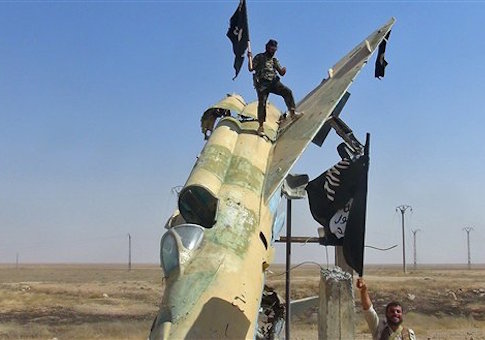Michael Morell’s insightful new book, The Great War of Our Time: The CIA’s Fight Against Terrorism,describes how the Central Intelligence Agency was the organization perhaps most affected by the rise of jihadist extremism following the terrorist attacks of September 11, 2001.
Serving as a presidential briefer and subsequently as deputy CIA director, Morell is well placed to discuss the challenges, opportunities, and frustrations the Agency faced in confronting terrorism. Much of the first half of the book does so competently.
Readers are given an inside look and riveting account of the hours after the 9/11 attacks when he was with President George W. Bush as the president received news of the attacks. Morell was a witness to history at that moment and describes those events in admirable detail.
That leads into a broader description of the ways in which the CIA was transformed into a paramilitary extension of U.S. counterterrorism policy, a major shift from its traditional focus on the collection and analysis of foreign intelligence. "9/11 changed CIA more than any other single event during my time at the Agency," Morrell writes.
Along the way the reader is offered glimpses of senior officials who shaped this policy, beginning with Presidents Bush and Obama, both of whom apparently appreciated Morell’s work and are mostly praised by him.
Not everyone gets off so easily. Vice President Cheney and his staff are accused of attempting to politicize intelligence reporting on Iraq—an ironic charge, given that Morell admits the reputedly objective CIA analysts harbored their own biases (which he describes as "rampant") against the Iraq invasion.
Sens. John McCain (R., Ariz.) and Lindsey Graham (R., S.C.) are charged with impugning Morell’s integrity while Porter Goss, the CIA director appointed by George Bush, is said to have given his aides "too much authority and they mismanaged the place." By contrast, he offers effusive praise for directors Panetta, Hayden, and Petraeus.
Readers may place those criticisms within the context that since leaving government service Morell has joined as senior counselor Beacon Global Strategies, a consulting firm co-founded by Phillippe Reines, a close associate of Hillary Clinton who also worked for Clinton in the State Department.
On a range of critical issues Morell is painstakingly honest. This stands in sharp contrast to colleagues such as John McLaughlin, another former deputy director, an unvarnished apologist for the Agency’s analytic and operational work on terrorism. Morell’s candor is refreshing and adds to the book’s credibility.
For example, he writes of the CIA’s Middle East assessments that "analysts for that region frequently produced pieces that did not advance the president’s thinking." Unfortunately, he never comes to grips with the reasons behind these failures, how poor analysis undermines policy maker confidence in CIA’s work, or if any remedial actions were put in place.
Along the way there are useful insights on a bureaucratic process that drives, and at times slows and confounds, the government’s counterterrorism policy. Relations between CIA and the post-9/11 established Office of the Director for National Intelligence (DNI) are characterized as "tense" because of perceived overlapping missions and inevitable suspicions and jealousies.
The idea of bureaucratic rivalries in Washington is hardly groundbreaking, but Morell speaks to this issue from an important vantage point. Again, one wishes he would offer insights into how the problems inherent in that relationship could be improved or what organizational fixes should be considered.
In Morell’s view there also are times when the national interest triumphed over petty bureaucratic machinations. He is generous—and rightly so—in praising the dedication and skills of Agency overseas personnel and counterparts in the Department of Defense Special Forces community, demonstrating that cooperation between bureaucracies is possible as well as essential for advancing U.S. interests.
Much of the second half of the book takes on a different, more defensive tone. He describes a policy process that too often is toxic, driven in Morell’s view by a desire on the part of many to "score political points" rather than advance the national interest.
Perhaps for this reason Morell becomes consumed with defending himself primarily and the Agency secondarily from charges related to the 2012 Benghazi attack, which resulted in the death of Ambassador Chris Stevens and three other Americans. He proceeds on a lengthy and at times tedious recounting of wrangling with some in Congress over those events, even advising the reader in advance to skip that chapter if so desired. Beyond satisfying Morell’s interests or those of his colleagues, it’s difficult to see how that discussion informs or benefits the reader.
If this is an error of commission, there is at least one of omission. Morell discusses the events in 2010-2011 that came to be known as the Arab Spring. He focuses on how al Qaeda benefited from the dramatic political upheavals in Tunisia, Egypt, and Syria.
That was an important development but Morell then stands silent on the far broader implications of the Arab Spring for the remaking of the Middle East and the still emerging sea change for U.S. interests.
Nonetheless, this and other shortfalls should not detract from the book’s core message. The rise of international terrorist organizations has become a dominant national security concern and the CIA’s important role in confronting it is placed in proper context by Morell’s highly readable book.
This is not a book on grand strategy and readers should look elsewhere if that’s what they want. Rather, Morell gives us a look at Washington’s bureaucratic battles—and occasional victories—in fighting terrorism that appear as chaotic and unpleasant in their own way as those in the Middle East.
